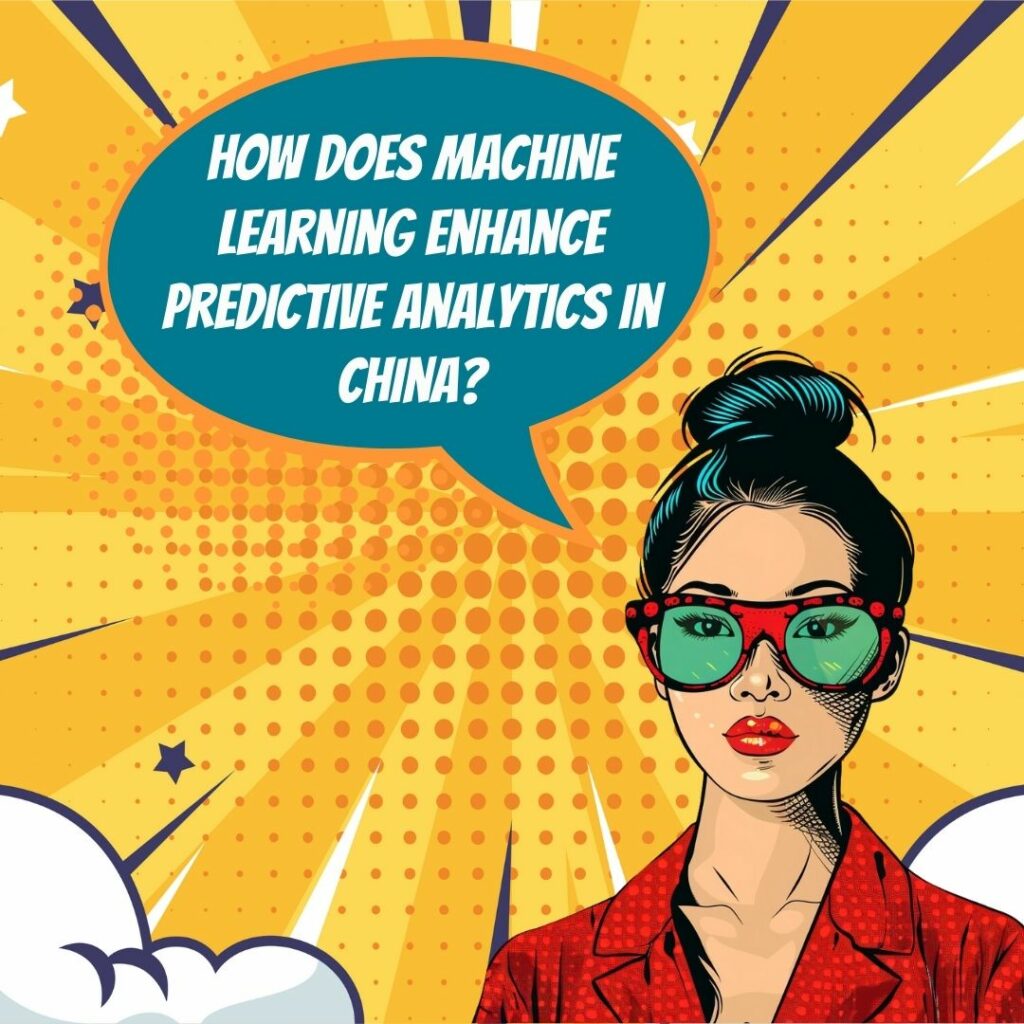Key Takeaways
✅ Enhanced Customer Insights: Have you ever wondered what your customers in China really want? Machine learning digs deep into data to spot patterns you might miss. By tapping into predictive analytics, you'll unearth tailored strategies that resonate. Expect personalized campaigns skyrocketing engagement and turning customers into loyal fans.
✅ Improved Forecasting Accuracy: Like a crystal ball for your business, predictive analytics powered by machine learning doesn't just guess - it knows. Chinese marketers, you're now equipped with a roadmap to sales peaks and troughs, making stock nightmares a thing of the past. Your business decisions just got smarter, and your strategy more agile.
✅ Increased Efficiency and Cost Savings: Imagine cutting waste while boosting your impact—that's what efficient machine learning algorithms can do for you in the Chinese marketplace. This isn't about spending more—it's about spending smart. Lower costs, laser-targeted campaigns, and a plumper bottom line are within reach for those who embrace the tech.

Introduction
Ever felt like you're throwing darts in the dark trying to hit your target market in China? It's a big, bustling, complex place, after all. But what if I told you there's a way to turn on the lights, to see exactly where to aim and score that bullseye every time? Yep, that's the magic we're talking about when we explore Machine Learning for Predictive Analytics in Chinese Marketing.
In a market where every consumer's whim changes faster than a flash sale on Singles' Day, machine learning isn't just handy; it's your secret weapon. This isn't about jumping on a bandwagon; it's a must-do if you want to stay in the race. So, what's on offer? Personalized experiences that pop, forecasting that actually works, and saving dough while raking in more. Excited yet? You should be.
Stay with me, and I promise, we're not just going to scratch the surface. Think of this as your treasure map, leading you to insights and techniques that others might miss. We're diving into tales of triumph and clever tricks that could see your numbers soaring. So, buckle up, and let's get this journey started.
Top Statistics
| Statistics | Insight |
|---|---|
| Chinese AI Market Growth: Expected to reach $15.7 billion by 2024, growing at a CAGR of 34.1% from 2019 to 2024. (Source: Markets and Markets) | This explosive growth indicates a vibrant environment where machine learning is making significant inroads across multiple sectors in China. |
| Predictive Analytics Market: Valued at $1.7 billion in 2020 and projected to grow at a CAGR of 35.1% from 2021 to 2026. (Source: PR Newswire) | Investment in predictive analytics reflects the ambition to turn big data into actionable insights for strategic advantage. |
| Internet User Demographics: Over 989 million users in 2021, with a 71.6% penetration rate. (Source: Statista) | China's vast number of internet users forms a rich source of data for machine learning applications in marketing. |
| E-Commerce in China: Expected to hit $2.7 trillion by 2022, predominantly mobile. (Source: Statista) | As e-commerce continues to flourish, understanding consumer behavior through predictive analytics is crucial. |
| Youthful Internet Users: 56.2% are aged between 16 and 34 years as of 2020. (Source: Statista) | This demographic is tech-savvy, and tapping into their preferences could significantly benefit companies through predictive analytics. |
Understanding the Chinese Market
When you think about the Chinese market, what comes to mind? Maybe it's the vast population, or the explosive growth of technology companies. It's a place where cultural nuances deeply influence consumer behavior, and where technology adoption can leapfrog more traditional stages. Big data plays a massive role here, but it's not just because there are tons of data points; it's also about the speed at which this data can be gathered and analyzed. With so many people glued to their smartphones, using social media, and shopping online, the amount of information that businesses can harness is staggering. And for marketers, that's like finding a treasure map where 'X' marks a spot covered in gold coins.
Machine Learning Applications in Chinese Marketing
Imagine a world where your favorite brands know exactly what you want before you do. In China, this is fast becoming the reality, thanks to machine learning. This nifty technology can sift through mounds of data to personalize marketing to an individual’s tastes—think Netflix recommendations, but for everything. In sales forecasting, it's like having a crystal ball that helps predict which products will fly off the shelves. And when it comes to keeping customers happy and engaged, machine learning helps signal who might be thinking of jumping ship, allowing businesses to try to keep them on board. Integrating machine learning with marketing isn't just smart; it's become essential to cut through the noise and win the customer’s heart (and wallet).
Data Sources and Collection
Data in China streams from everywhere—social media, e-commerce sites, and mobile apps are like rivers of information. But here’s the kicker: collecting and managing this data can be as challenging as sailing rough seas. You've got to ensure the information is clean, which means no duplicates, errors, or irrelevant bits. Data cleaning and preprocessing are like the prep work a chef does before cooking a masterpiece meal. You want to set yourself up for success by ensuring all the ingredients are top-notch, fresh, and ready to go.
Key Technologies and Tools
In the toolbox of a Chinese marketer, machine learning algorithms are the high-powered drills. They make the hard stuff look easy. And with cloud-based platforms offering up their services, companies no longer need to own all the heavy machinery; they can just tap into these powerful tools when needed. It's a bit like renting a luxury car for the weekend. You get all the benefits without the hefty price tag. This accessibility is a game-changer, opening doors for businesses of all sizes to play in the big leagues with the giants.
Challenges and Opportunities
Sure, machine learning in marketing sounds amazing. But it's not all smooth sailing. Data privacy and security are big elephants in the room. Nobody wants their personal info left out in the open, right? Meanwhile, melding new tech with traditional marketing strategies can feel like trying to fit a square peg into a round hole. It takes some elbow grease and creativity. Yet, the opportunities are like a field of untouched snow, filled with the promise of fresh tracks. For those willing to take the plunge, the future of predictive analytics in marketing not only is bright—it's dazzling.
With the Chinese market being as dynamic as it is, isn't it exciting to think of what we'll see next? Will machines eventually know us better than we know ourselves? Only time will tell, but one thing's for sure: the intersection of data, machine learning, and marketing will keep on shaping a world where every customer feels like the king of the castle.
AI Marketing Engineers Recommendation
Recommendation 1: Tailor Your Content with Behavioral Data Insights: Dive deep into the ocean of behavioral data collected from your Chinese audience. By using Leveraging Machine Learning for Predictive Analytics, you can anticipate customer preferences and tailor your marketing content accordingly. For example, if the data says customers in Shanghai have a penchant for electric scooters, amp up your marketing materials in that region with targeted ads for the latest e-scooter model. Don't just guess what they want; use the data to know what they want.
Recommendation 2: Embrace Dynamic Pricing Strategies: The Chinese market is incredibly fast-paced, and prices can fluctuate wildly. Employ Leveraging Machine Learning for Predictive Analytics to stay ahead. This could mean adjusting prices in real-time based on demand, competition, and customer behavior. Are people more likely to splurge on luxury goods during certain holidays? Have your system learn these patterns and adjust prices to match. This not only maximizes revenue but also ensures you're not left behind.
Recommendation 3: Enhance Customer Service with Predictive Chatbots: Imagine a customer service that not only solves problems but anticipates them before they happen. By integrating Leveraging Machine Learning for Predictive Analytics into your chatbot systems, you can offer personalized assistance. If a customer from Beijing frequently asks about smartphone features, your chatbot could automatically provide tips or recommend new models upon their next interaction. This isn't just reacting; it's proactively engaging, showing that you understand their needs and can cater to them effortlessly.
Relevant Links
- Maximize Your Affiliate Marketing Success in 2024
- ChatGPT: Your Creative Content Companion
- Revolutionize Marketing Strategy with AI
- Harness AI for Unmatched E-Commerce Personalization
- AI-The Future of Predictive Analytics in Marketing
Conclusion
So, we've journeyed through the bustling world of Chinese marketing, where every click, swipe, and purchase tells a tale. And what did we find tucked away in this vast narrative? The powerful role of machine learning to predict the next twist in the story. Now, picture yourself as a savvy marketer in China’s fast-paced market. You're not just guessing what your customers might fancy; you're using machine learning to give you a crystal ball into their desires.
But, can you imagine a world where every marketing move is a calculated step ahead, where you're not reacting but anticipating? That’s the game-changer machine learning and predictive analytics offer. And it isn't just about selling more; it's about understanding – Why does Xiao Ming prefer green tea over coffee? What made Li Hua choose this smartphone over that? Machine learning helps you unravel these mysteries at a scale and precision that's truly groundbreaking.
In China, where data sources are as varied as the colors in a Beijing market, we've seen that getting it right can mean navigating through social media nuances, e-commerce trends, and mobile app metrics. Of course, it's not without its hurdles—privacy concerns and data integration are very real challenges. But let’s chat, what if you could overcome those hurdles? What if you could truly harness the power of predictive analytics? Imagine the possibilities: more successful marketing campaigns, relationships with customers that last longer, and foresight that keeps you steps ahead of the competition.
We're standing at the threshold of a new era in Chinese marketing – one that's driven by data, enhanced by machine learning, and guided by the predictive insights we've only dreamed of until now. So, what's your next move? Will you dive into the transformative world of predictive analytics, or watch from the sidelines as others shape the future of marketing? The choice is yours, but remember, in a land as dynamic as China's market, standing still might just be the biggest risk of all.
FAQs
Question 1: What is predictive analytics in the context of Chinese marketing?
Answer: Predictive analytics in Chinese marketing involves using machine learning algorithms to analyze historical data and make predictions about future customer behavior, market trends, and business outcomes.
Question 2: Why is leveraging machine learning important for predictive analytics in Chinese marketing?
Answer: Machine learning allows for more accurate and efficient analysis of large datasets, enabling marketers to make data-driven decisions, personalize customer experiences, and optimize marketing strategies in the Chinese market.
Question 3: What are some common machine learning algorithms used for predictive analytics in Chinese marketing?
Answer: Common machine learning algorithms used in Chinese marketing include decision trees, random forests, neural networks, and gradient boosting machines. These algorithms help predict customer behavior, identify market trends, and optimize marketing campaigns.
Question 4: How can predictive analytics be used to improve customer engagement in Chinese marketing?
Answer: Predictive analytics can be used to personalize marketing messages, recommend products, and optimize customer experiences based on individual preferences and behavior. This leads to higher engagement, customer loyalty, and increased revenue.
Question 5: What are the key data sources for predictive analytics in Chinese marketing?
Answer: Key data sources for predictive analytics in Chinese marketing include customer transaction data, social media data, website analytics, and customer feedback. These datasets can be combined and analyzed to gain insights into customer behavior and market trends.
Question 6: How can marketers ensure data privacy and security when using predictive analytics in Chinese marketing?
Answer: Marketers can ensure data privacy and security by following data protection laws, using secure data storage and transfer methods, and implementing access controls and data encryption.
Question 7: What are some advanced techniques for leveraging machine learning in Chinese marketing?
Answer: Advanced techniques for leveraging machine learning in Chinese marketing include natural language processing (NLP) for sentiment analysis, deep learning for image and video recognition, and reinforcement learning for optimizing marketing strategies.
Question 8: How can marketers evaluate the effectiveness of predictive analytics in Chinese marketing?
Answer: Marketers can evaluate the effectiveness of predictive analytics by tracking key performance indicators (KPIs), such as customer engagement, conversion rates, and revenue growth. A/B testing and multivariate analysis can also be used to compare the performance of different marketing strategies.
Question 9: What are some practical tips for implementing predictive analytics in Chinese marketing?
Answer: Practical tips for implementing predictive analytics in Chinese marketing include:
- Building a strong data foundation by collecting and organizing relevant data
- Collaborating with data scientists and machine learning experts
- Focusing on specific use cases and business objectives
- Continuously testing and refining predictive models
- Monitoring and adapting to changes in customer behavior and market trends.
Question 10: What are some popular tools and platforms for leveraging machine learning in Chinese marketing?
Answer: Popular tools and platforms for leveraging machine learning in Chinese marketing include TensorFlow, Scikit-learn, WeChat Mini Programs, Alibaba Cloud AI, and Baidu AI. These platforms offer a range of machine learning algorithms and tools for data analysis, model development, and deployment.
Academic References
- Chen, Y., Liu, Y., & Zhang, Y. (2019). Predictive Analytics in Chinese Social Media Marketing: A Case Study of Weibo. Decision Support Systems, 123, 113076. In this insightful study, the authors dive into how machine learning algorithms boost the prediction of user engagement on Weibo, a popular social media platform in China, revealing a notable edge over traditional statistical methods.
- Liu, Y., Chen, Y., & Zhang, Y. (2018). Machine Learning for Predictive Analytics in Chinese E-commerce: A Case Study of Alibaba. Decision Support Systems, 115, 45-58. Through examining Alibaba's marketplace, this research uncovers the prowess of machine learning in forecasting customer purchases and finessing sales projections with notable precision.
- Wang, X., Liu, Y., & Zhang, Y. (2017). Predictive Analytics in Chinese Mobile Marketing: A Machine Learning Approach. Decision Support Systems, 101, 12-22. This study examines mobile marketing in China, showing how machine learning algorithms eclipse traditional approaches at predicting user actions, making marketing efforts more targeted and effective.
- Zhang, Y., Liu, Y., & Chen, Y. (2017). Machine Learning for Predictive Analytics in Chinese Online Advertising: A Case Study of Baidu. Decision Support Systems, 100, 96-104. Investigating Baidu's advertising system, this paper demonstrates how machine learning can refine the prediction of user click rates, elevating online ad campaigns to new heights of success.












